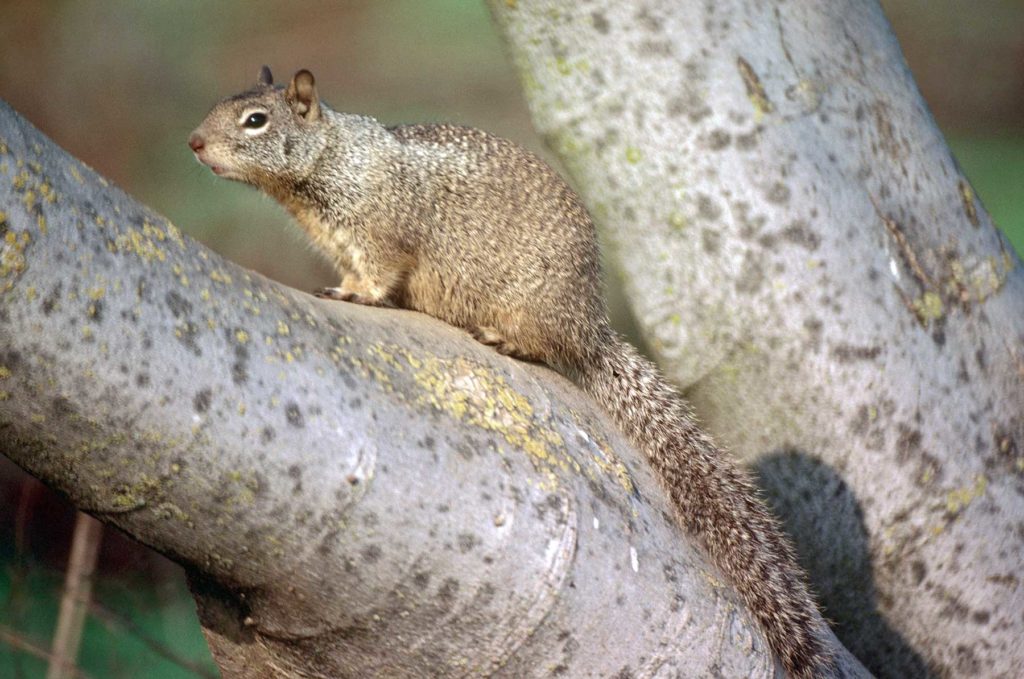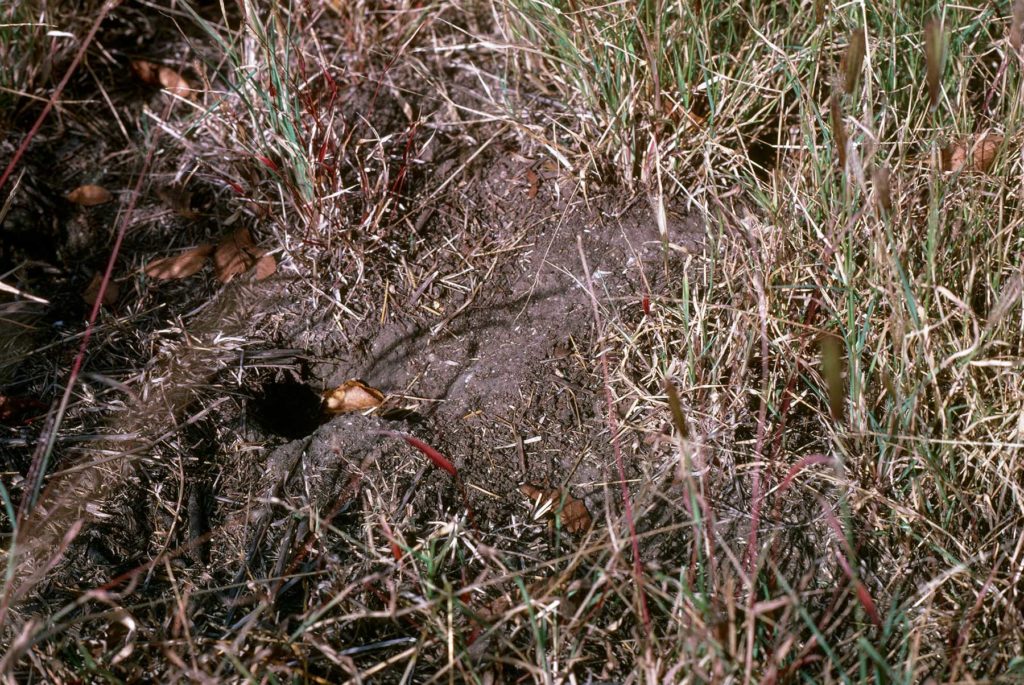Vertebrate pests chew the bark on young trees, create extensive burrow systems that pose problems with equipment movement and worker safety, damage irrigation lines and in extreme situations, affect crop yields. Roger Baldwin, UCCE wildlife specialist, said that correct identification of the problem species is the first step in controlling populations. What may work for ground squirrel control won’t be as effective against a vole invasion. Understanding biology and habitat of the target species will help with choosing the most effective control strategies.
Identify the Pest
California ground squirrels are a common pest in many tree nut orchards. They are a social, diurnal species that can girdle young trees, chew irrigation lines and cause crop losses. Baldwin, in a presentation at Pistachio Day 2020, said these mottled grey-brown rodents live in burrows that are normally two-three feet below ground. Ground squirrels are active during the day and have two periods of dormancy during the year. They hibernate during the winter months, but some young can be active when winters are not severe. During summer when temperatures are high, they have a period of inactivity called estivation that can last a few days to a week or more.
California ground squirrel mating period can start as early as January in warmer locations and continue through June. One litter per year is produced. Ground squirrels usually forage close to their burrows. Their home range typically is within a 75-yard radius of their burrow. After hibernation, ground squirrels feed on green grasses and plants. When annual plants begin to dry and produce seed, squirrels switch to seeds, grains, and nuts, and begin to store food.
Pocket gophers are another burrowing rodent and their presence in an orchard can be determined by the presence of fan-shaped mounds of dirt on orchard floors. Adults are 6 to 10 inches long, including their short tail.
Pocket gophers live in a burrow system that is usually 6 to 12 inches below ground. They are active year-round, and can be active any time of the day or night. They feed on plant roots as they dig burrows, including the roots of young trees, girdling roots below the soil line. Gophers also damage irrigation systems by gnawing on the plastic tubing. Their tunnels can divert water from the root zone. Pocket gophers are more common in alfalfa fields and vineyards, but can also invade nut orchards.
Meadow mice or voles are smaller rodents and their populations tend to be cyclical, but can explode in a short time. Like pocket gophers, they also gnaw and girdle young trees, but their damage is generally above ground.

Integrated Management Strategies
Once identified, management strategies can be implemented. Understanding the biology of the rodent pest and the ecology of the infested site are the first steps in managing the pest.
“Using multiple tools will give better results,” Baldwin said. An integrated approach to rodent pests requires several tools, including habit modification, baits, fumigation, trapping and repellents.
Modify habitat for control of rodent pests in an orchard by removing brush piles and destroying burrows. Vegetation that provides cover for rodents should be removed. If ground squirrels are the problem, the plan should also include burrow destruction so squirrels don’t re-invade the site.
Voles seek vegetation cover when above ground. Mowing an orchard cover crop close to the ground can help along with burrow destruction. Exclusion can be an effective tactic for pocket gophers, removing young trees as a food source by using tree wraps. To be effective tree wraps have to protect tree trunks six inches below the soil line.
Baits work best if set out during the time of year they will be sought by rodent pests. Baiting ground squirrels with treated grain is effective in summer and fall because they feed primarily on seeds that time of year.
Baldwin said bait placement is key. Bait application for gophers is only allowed directly within burrow systems.
With pocket gophers, bait should be placed in the main tunnel. After locating a tunnel and making sure it is an active tunnel, bait can be carefully deposited in the tunnel. Strychnine-treated grain is the most effective bait for pocket gopher control. Zinc phosphide baits are also available and like strychnine, both are lethal after a single dose. These treated baits are only legal if placed inside burrows. Anticoagulant baits can be used, but need to be in larger amounts since they require multiple feedings to be lethal.
Bait stations for rats and mice are effective, but they can only be used during the winter months.
Burrow fumigation is most effective in spring, when moist soil helps seal gasses in the burrow system. Fumigating at this time is also more effective in reducing ground squirrel numbers since squirrels die before they can reproduce.
If squirrel numbers are low to moderate, trapping is a practical approach. Live catch traps require euthanasia by methods considered humane by the American Veterinary Medical Association. Drowning is not an approved method of euthanasia and is illegal in California.

Box traps and tunnel traps that kill can be placed near burrows or runways and baited. Baldwin recommends not setting the traps for the first few days so squirrels become accustomed to them. Once the squirrels are taking the bait, the traps can be set. Monitoring populations for reinfestation is necessary since squirrels will reinvade over time. Be on the lookout for new burrows. It is easier and less expensive to manage a small population rather than to allow it to build up to larger numbers. Trapping is a time consuming, but effective method for gopher control. Two-pronged pincer traps, such as Macabee, Cinch or Gophinater work well. Traps should be set in all tunnels present and wired to stakes to retrieve them from the burrows. Baldwin said there is no advantage to covering trap sets other than to eliminate non-target species trapping.
Promoting biological control is another option. Predators including owls, snakes and coyotes will seek out squirrels and gophers as a food source, but before they eliminate the pest, they generally move on to where prey is more available.
More detailed information about identification, management, and other resources is available at the UC Ground Squirrel Best Management Practices website, www.groundsquirrelbmp.com.

Cecilia Parsons
Cecilia Parsons has lived in the Central Valley community of Ducor since 1976, covering agriculture for numerous agricultural publications over the years. She has found and nurtured many wonderful and helpful contacts in the ag community, including the UCCE advisors, allowing for news coverage that focuses on the basics of food production.
She is always on the search for new ag topics that can help growers and processors in the San Joaquin Valley improve their bottom line.
In her free time, Cecilia rides her horse, Holly in ranch versatility shows and raises registered Shetland sheep which she exhibits at county and state fairs during the summer.
















